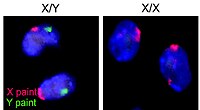
| Part of a series on |
| Sex |
|---|
 |
| Biological terms |
| Sexual reproduction |
| Sexuality |
| Sexual system |
Sexual dimorphism is the condition where sexes of the same species exhibit different morphological characteristics, including characteristics not directly involved in reproduction.[1] The condition occurs in most dioecious species, which consist of most animals and some plants. Differences may include secondary sex characteristics, size, weight, color, markings, or behavioral or cognitive traits. Male-male reproductive competition has evolved a diverse array of sexually dimorphic traits. Aggressive utility traits such as "battle" teeth and blunt heads reinforced as battering rams are used as weapons in aggressive interactions between rivals. Passive displays such as ornamental feathering or song-calling have also evolved mainly through sexual selection.[2] These differences may be subtle or exaggerated and may be subjected to sexual selection and natural selection. The opposite of dimorphism is monomorphism, when both biological sexes are phenotypically indistinguishable from each other.[3]
- ^ Encyclopedia of Animal Behaviour. Vol. 2. Academic Press. 21 January 2019. p. 7. ISBN 978-0-12-813252-4.
- ^ Ralls K, Mesnick S (2009). "Sexual dimorphism". Encyclopedia of Marine Mammals. Academic Press. pp. 1005–1011. doi:10.1016/B978-0-12-373553-9.00233-9. ISBN 9780123735539.
- ^ "Dictionary of Human Evolution and Biology". Human-biology.key-spot.ru. Archived from the original on 7 November 2017. Retrieved 3 November 2017.